Posted December 1, 2023 by Tiffany Lee
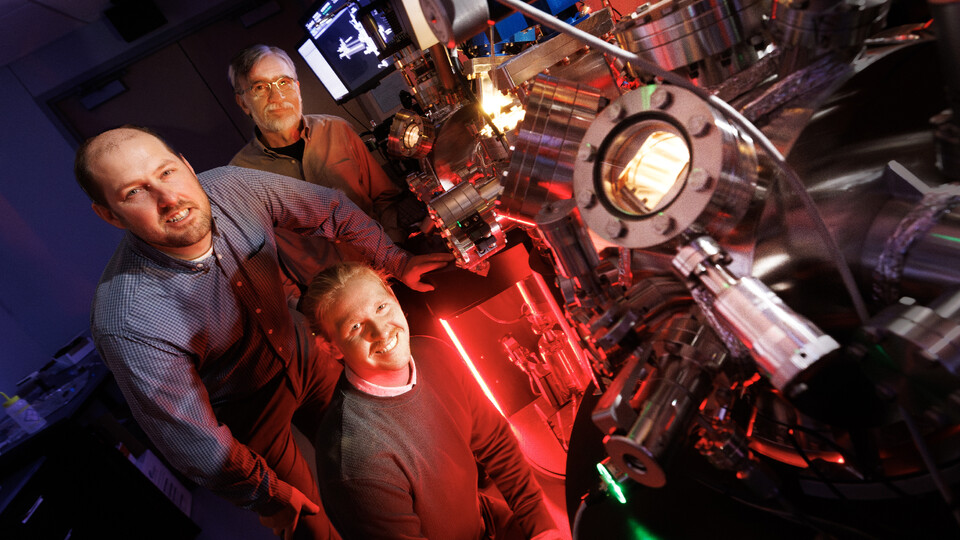
Nebraska U’s new laser to facilitate manufacturing method of the future
Who: Craig Zuhlke, associate professor of electrical and computer engineering; George Gogos, Wilmer J. and Sally L. Hergenrader Professor of Mechanical and Materials Engineering; Graham Kaufman, doctoral student in electrical engineering
What: Zuhlke and Gogos co-direct the Center for Electro-Optics and Functionalized Surfaces, which is now home to a first-of-its-kind laser in the United States to be used for a specialized method of surface modification. The method, called femtosecond laser surface processing, has a wide variety of applications in space, defense, medicine and beyond, but there are obstacles to its widespread industrial use. The new laser will help Husker researchers overcome a major barrier – scalability – by enabling production of larger quantities of raw materials with modified surface properties.
“The new laser will be able to functionalize about 50 times faster than we can right now,” Gogos said. “There are members of the space and defense industries that are aware we have this laser, and there’s an interest for additional work, funding and collaborations because of this scalability.”
Writer: Tiffany Lee, Office of Research and Economic Development
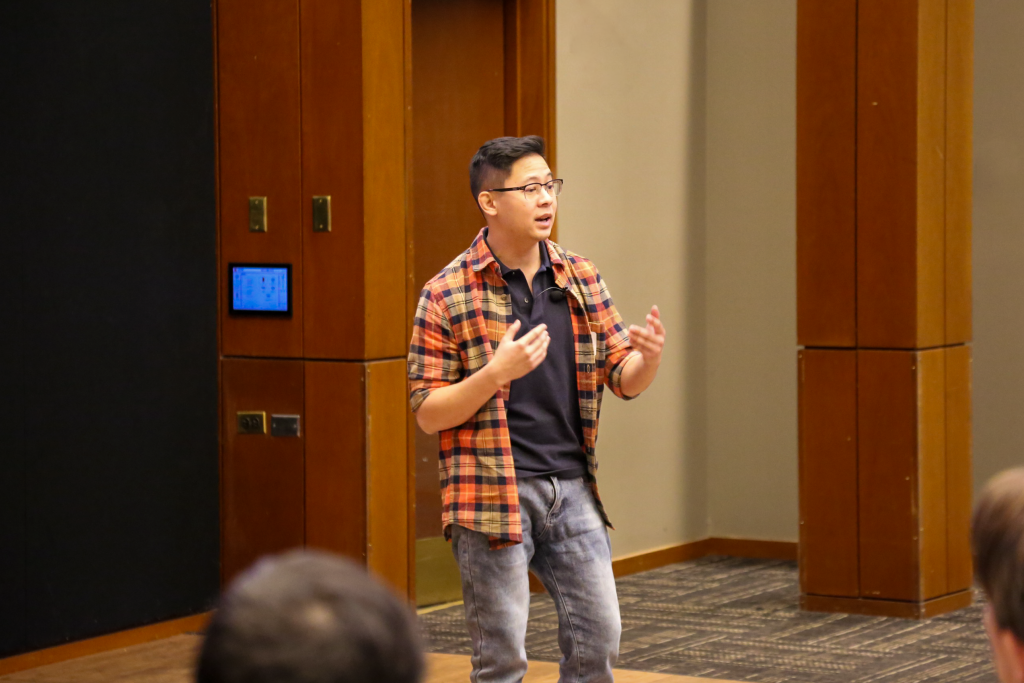
Tan wins Faculty Slam; clinches CoJMC’s three-peat
Who: Ryan Tan, assistant professor of sports media and communications
What: Tan was selected by spectators as the winner of the 2023 Faculty Research and Creative Activity Slam, held Nov. 8 as part of Nebraska Research Days. Tan’s presentation focused on his research to determine the cognitive and emotional effects that video games have on players. Slammers responded to the prompt: “What do your friends and family members find most interesting about the work you do?” The other contestants were Ciara Ousley, assistant professor of special education and communication disorders; Ruth Woiwode, assistant professor of animal science; Mohammad Hasan, assistant professor of electrical and computer engineering; and Gwendŵr Meredith, assistant professor in the School of Natural Resources.
““What if we designed games for good? What if we designed games for social change?” Tan said. “That’s my research now. That is what I want to be remembered for.”
Writer: Dan Moser, Office of Research and Economic Development
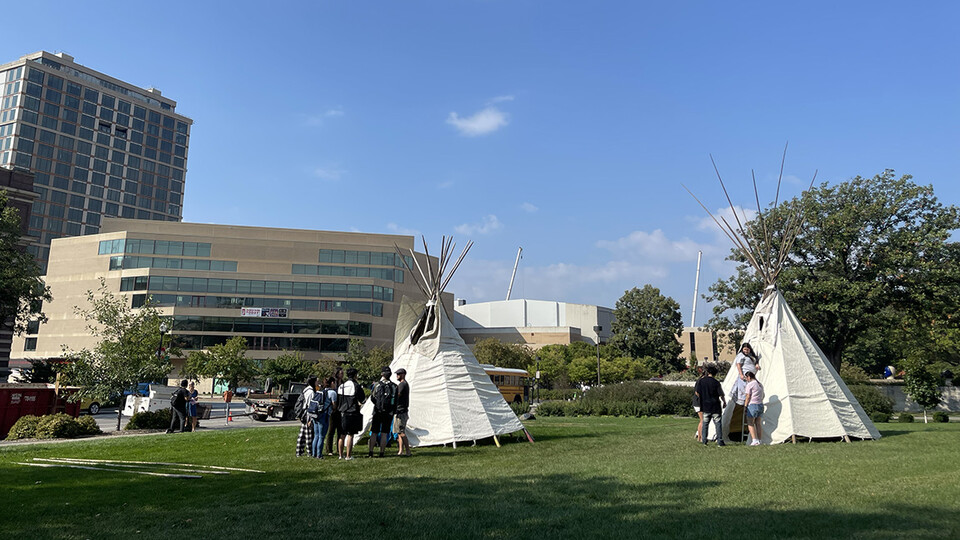
Otoe-Missouria, Center for Great Plains Studies earn Mellon funding
Who: Margaret Jacobs, Charles Mach Professor of History and director of the Center for Great Plains Studies; Christina Faw Faw Goodson, member of the Otoe-Missouria Tribe and Native language specialist with the National Indian Education Association
What: The Center for Great Plains Studies and the Otoe-Missouria Tribe were awarded a $1.58 million grant from the Mellon Foundation to launch a project that promotes healing and reconciliation in southeast Nebraska by reconnecting the Otoe-Missouria to their homelands – which include Salt Creek in Lincoln – and educating non-Native people about the tribe and other Indigenous people in the region. The project includes a survey of the current commemorative landscape; co-creation of new commemorations of Native people; and documentation of the process.
“Many Indigenous people, their presence and place has been almost entirely erased,” Jacobs said. “I would venture to guess that most people who live here (in Lincoln) don’t know the tribe that ceded the land that became our city, our university. It was such a wake-up call for me that I wasn’t aware of it.”
Writer: Deann Gayman, University Communication and Marketing
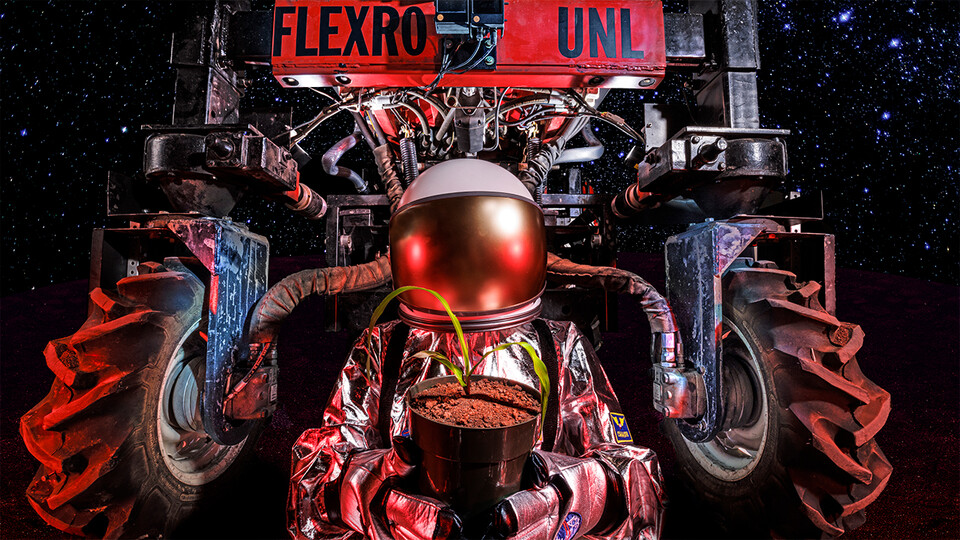
Huskers aim to launch first center for space agriculture
Who: Santosh Pitla, associate professor of biological systems engineering; Yufeng Ge, professor of biological systems engineering and Eberhard Professor of Agriculture; David Jones, professor of biological systems engineering
What: Pitla and Ge formed the Consortium of Space, Policy, Agriculture, Climate and Extreme Environment, or SPACE2, with the goal of finding ways to sustainably grow food on space stations, the moon, Mars and other celestial bodies that humans may eventually call home. The consortium leverages Nebraska’s strengths across multiple disciplines, including agriculture, law, engineering and emerging media arts, among others. Pitla and Ge hope SPACE2 will serve as the foundation for an eventual center dedicated to the study of space agriculture at Nebraska; currently, no U.S. university houses such a center.
“If NASA or the big space companies — SpaceX, Virgin Galactic, Blue Origin — want to go out and work with a university, who would that be?” Pitla said. “We have been doing ag research for more than 100 years, and we’re an ag state. Why reinvent the wheel somewhere else when we already have all this experience?”
Writer: Scott Schrage, University Communication and Marketing
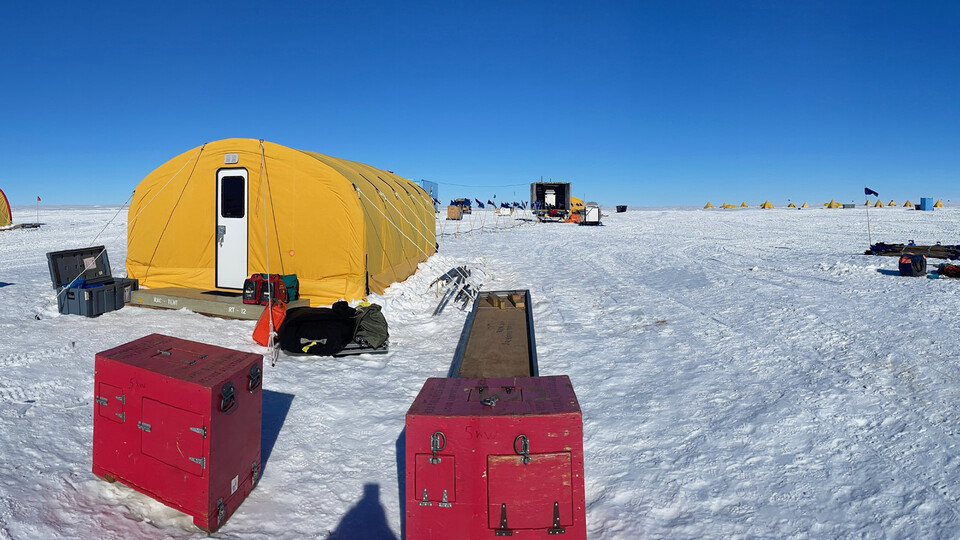
Husker expertise featured in new Antarctic study
Who: David Harwood, professor of Earth and atmospheric sciences; Jason Coenen, postdoctoral researcher in Earth and atmospheric sciences; Megan Heins, doctoral student in geosciences
What: Husker researchers are part of a multinational team working in a remote part of Antarctica to conduct research that will help predict how fast the West Antarctic Ice Sheet will melt as the result of global and ocean warming. During the project, the research team will drill up to 200 meters into the sediments beneath the Ross Ice Shelf, searching for clues about its previous responses to global temperature fluctuations. The team’s findings will help the world adapt to rising sea levels and encourage efforts to reduce greenhouse gas emissions. The Huskers’ participation extends UNL’s 50-year history of leadership in the Antarctic science.
“Our planet is at risk and we need information from the heart of Antarctica, at the vulnerable margins of the West Antarctic Ice Sheet, to understand how it will behave in the future as Earth warms,” Harwood said.
Writer: Leslie Reed, University Communication and Marketing

Research eyes optimized design for web, mail surveys
Who: Kristen Olson, Leland J. and Dorothy H. Olson Professor of sociology and director of the Bureau for Sociological Research; Jolene Smyth, professor and chair of sociology; Angelica Phillips, graduate student in sociology
What: The team co-authored a study exploring how the design and display of mixed modality surveys affect the quality of the data collected. The study – which is among the first to look at web and mail surveys together – investigated how the method of displaying questions and the types of response buttons available for participants to use impact their responses. The team’s findings suggest optimizing survey design for a particular mode may yield improved data.
“The prevailing wisdom for questionnaire design with multiple modes is to use what’s called a unified mode design, which is to make things look as similar as possible across the modes,” Olson said. “This shows a different approach, or an optimized mode design, where you optimize the design for each mode, can get better quality answers within each mode and therefore minimize measurement error.”
Writer: Deann Gayman, University Communication and Marketing
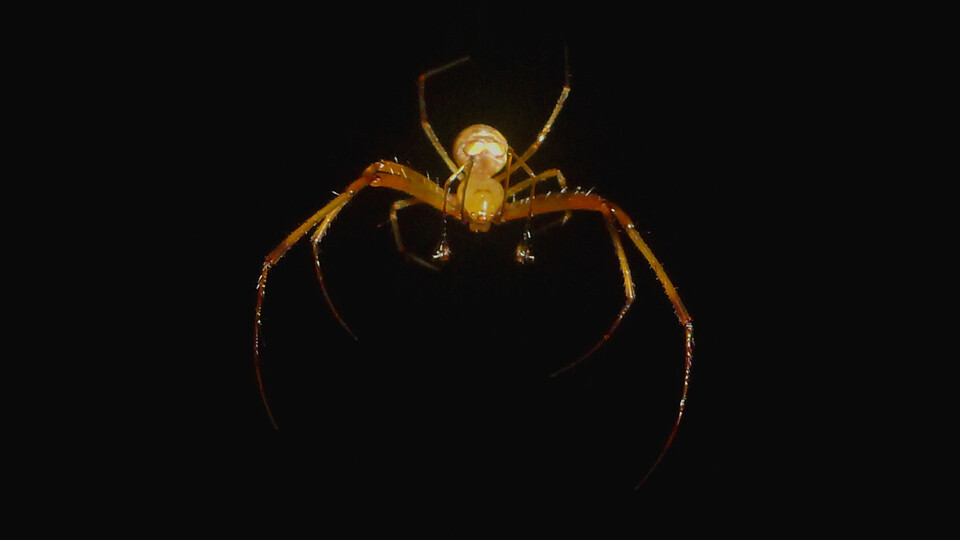
Silk lines help pirate spiders trick, capture eight-legged prey
Who: Laura Segura Hernández, former graduate student in biological sciences; Gilbert Barrantes, University of Costa Rica; Diego Solano-Brenes, University of São Paulo
What: While walking in a Costa Rican rainforest, Segura Hernández and her collaborators observed the pirate spider Gelanor siquirres engaging in a previously unknown foraging strategy: It had dropped four lines of silk as a web to catch other spiders at dusk. This is strategic because nightfall is when a large number of spiders – potential prey for G. Siquirres – are beginning to construct webs. The arachnologists wrote a paper published in Animal Behaviour describing the never-before-documented phenomenon and theorizing about the evolutionary forces behind it. The finding highlights the importance of making observations in the natural world.
“One of my favorite things about this paper is that it highlights how important it is … to observe and just pay attention to detail,” Segura Hernández said. “Sometimes people are so focused on hypotheses and questions that they kind of forget about the organisms. But I think both things are equally important.”
Writer: Scott Schrage, University Communication and Marketing
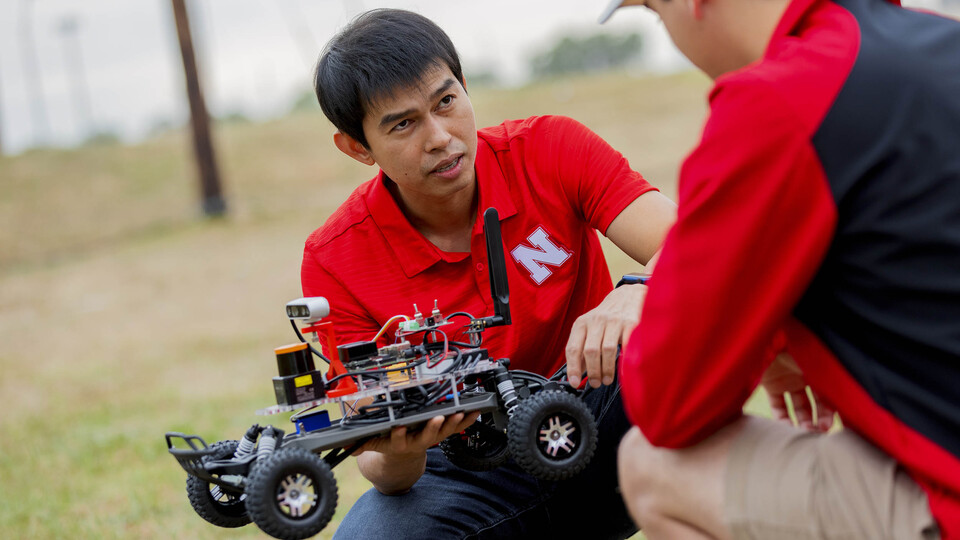
Tran’s new tool may make autonomous vehicles safer and smarter
Who: Dung Hoang Tran, assistant professor of computing
What: With support from the National Science Foundation, Tran is advancing his work on a verification tool that will make autonomous vehicles and other robotics machinery safer and smarter. The work builds on a type of safety verification software that Tran developed as a doctoral student, called the Neural Network Verification tool, which is used by Apple, Boeing, Toyota and more. His new framework will be capable of certifying whether a system passes or fails safety tests and analyzing the probability of risk involved in deploying a vehicle or machine in an unfamiliar environment.
“In our new framework, we can also ask, ‘If it’s unsafe, then how unsafe?’” Tran said. “It models the uncertainty of the environment, and that is going to give you the probability of a specification or a requirement being violated, which is very important for decision-making or control.”
Writer: Victoria Grdina, School of Computing
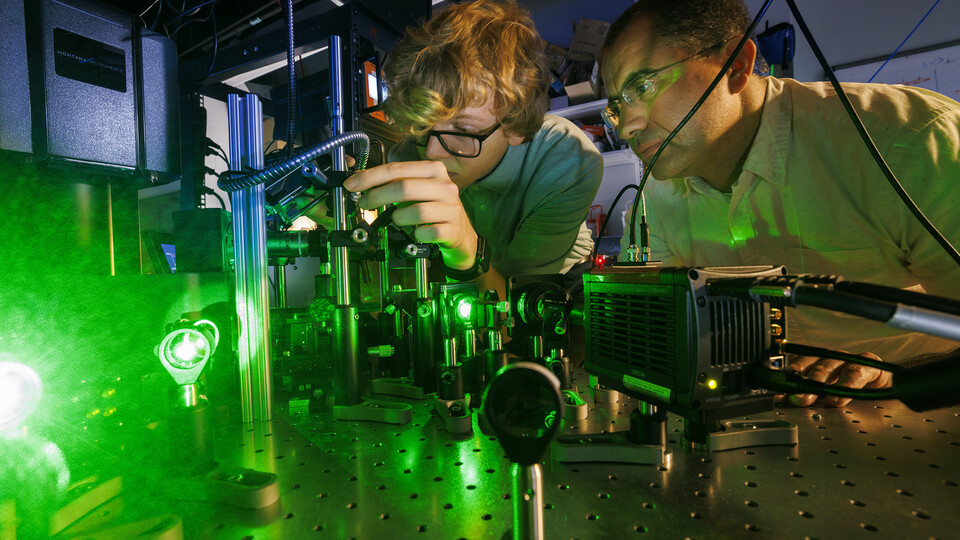
Laraoui and team improve performance of quantum computers
Who: Abdelghani Laraoui, assistant professor of mechanical and materials engineering; Kapildep Ambal and Jian Wang, Wichita State University
What: With an $800,000 Track 1 award from the National Science Foundation’s Expand Capacity in Quantum Information Science and Engineering (ExpandQISE) program, the team is seeking materials for quantum computers that would open the door to greater efficiency and scalability. Though these ultrafast computers have many advantages compared to traditional systems, a barrier to their widespread use is that they require very low-temperature environments to operate. Laraoui’s team aims to pinpoint more robust materials that could function at higher temperatures.
“Quantum computers can do calculations in two minutes that would take 10,000 years if you used a classical system, but right now, they are difficult to scale up (for wider use) because they have to exist in very low-temperature environments, and that is very expensive to create,” Laraoui said.
Writer: Karl Vogel, College of Engineering





